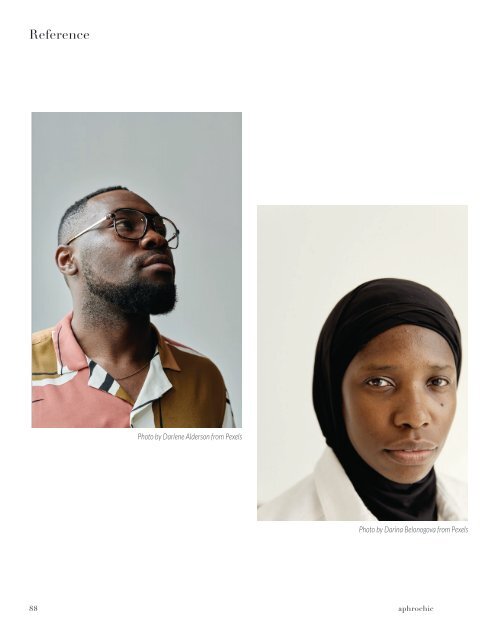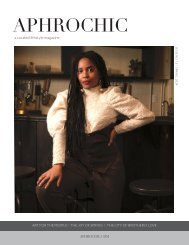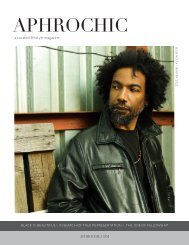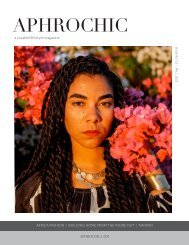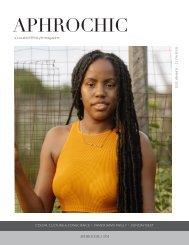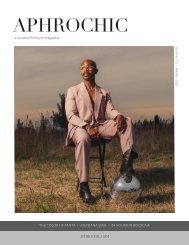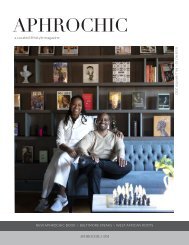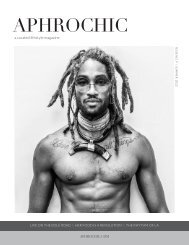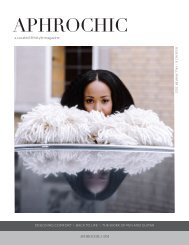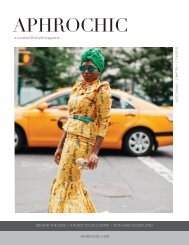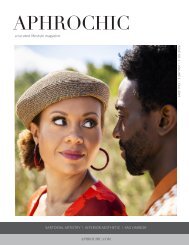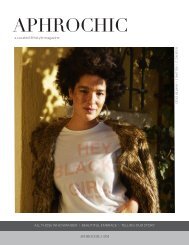Aphrochic Magazine: Issue No. 7
For our Summer 2021 issue, we have an issue full of color, life and all of the things that make our Diaspora beautiful. For our cover story, we are thrilled to sit down with one of our favorite folks in fashion, the amazing Charles Harbison. After a 5-year hiatus and a cross-country jump from New York to Los Angeles, Charles is back with the much-anticipated return of his eponymous fashion line, HARBISON. We also sit down with the iconic Dyana Williams. A legend of the Philadelphia radio scene that we grew up on, she’s better known outside the city as the mother of Black Music Month. We sat down with Dyana to talk about Black music, the newly opened National Museum of African American Music and the artists on her playlist that she feels are doing the most for the culture. In our Hot Topic, AphroChic contributor Ruby Brown takes an incisive look at Pride, all that the LGBTQIA+ community has accomplished and all that’s left to do. And in response to the growing debate over Critical Race Theory, which in the last months has taken over news feeds and legislative floors alike, we take a break from our ongoing discussion of the African Diaspora to offer a brief exploration of CRT, it’s origins, it’s concepts and why it seems to have everyone so upset. Throw in some amazing art from THE CONSTANT NOW gallery in Antwerp, inspirational words from author Alexandra Elle, and the latest updates from the outdoor spaces at the AphroFarmhouse and we think this issue will have you ready for the summer season.
For our Summer 2021 issue, we have an issue full of color, life and all of the things that make our Diaspora beautiful. For our cover story, we are thrilled to sit down with one of our favorite folks in fashion, the amazing Charles Harbison. After a 5-year hiatus and a cross-country jump from New York to Los Angeles, Charles is back with the much-anticipated return of his eponymous fashion line, HARBISON. We also sit down with the iconic Dyana Williams. A legend of the Philadelphia radio scene that we grew up on, she’s better known outside the city as the mother of Black Music Month. We sat down with Dyana to talk about Black music, the newly opened National Museum of African American Music and the artists on her playlist that she feels are doing the most for the culture.
In our Hot Topic, AphroChic contributor Ruby Brown takes an incisive look at Pride, all that the LGBTQIA+ community has accomplished and all that’s left to do. And in response to the growing debate over Critical Race Theory, which in the last months has taken over news feeds and legislative floors alike, we take a break from our ongoing discussion of the African Diaspora to offer a brief exploration of CRT, it’s origins, it’s concepts and why it seems to have everyone so upset.
Throw in some amazing art from THE CONSTANT NOW gallery in Antwerp, inspirational words from author Alexandra Elle, and the latest updates from the outdoor spaces at the AphroFarmhouse and we think this issue will have you ready for the summer season.
You also want an ePaper? Increase the reach of your titles
YUMPU automatically turns print PDFs into web optimized ePapers that Google loves.
Reference<br />
Photo by Darlene Alderson from Pexels<br />
its basic principles are:<br />
1. That racism is not a biological fact but a<br />
socially constructed set of categories designed<br />
to codify a specific set of power relationships.<br />
Therefore race is not real, but racism is.<br />
2. That racism is normal in American<br />
society. It is not an aberration, the exception to<br />
the rule or restricted to the thoughts and actions<br />
of a marginalized few. It is the daily lived experience<br />
of most, if not all, people of color in this<br />
country.<br />
3. The establishment and protection<br />
of racist power differentials is encoded into<br />
American society, enforced by its laws and<br />
expressed in its public policy. These structures<br />
normalize the habitually racist perspectives and<br />
processes of the country making them invisible<br />
or at least deniable.<br />
4. The process of legislative racial progress<br />
and regression in America — such as affirmative<br />
action or legalizing marijuana — is often manipulated<br />
to serve white interests. Simultaneously,<br />
actions designed to benefit whites are often<br />
branded as progress for people of color.<br />
5. Accurate and adequate representation<br />
is crucial. The same mechanisms of control<br />
which are used to ascribe negative stereotypes<br />
to people of color are used to deny our ability to<br />
speak accurately and meaningfully to our own<br />
experiences of racism in legal, political, and<br />
social settings.<br />
6. That humanity is intersectional and no<br />
one person can be fully described by their membership<br />
in a single group. Every person has a<br />
race, gender identity, ethnicity, sexual preference,<br />
etc., and their experience of society will<br />
be determined largely by the groups that they<br />
belong to.<br />
Where Did It Come From?<br />
Even though a lot of the controversy and<br />
anger around CRT seems very new, the idea<br />
itself started back in the 1970s and has roots<br />
that go back even further. Initially CRT grew<br />
in the aftermath of the Civil Rights Movement<br />
as scholars of color sought to understand why<br />
the gains of the movement were not resulting<br />
in the level of change they had anticipated and<br />
why many of those gains seemed under constant<br />
threat of being rolled back. Continued disparities<br />
in education following the Brown v. Board<br />
of Education case were of particular interest to<br />
Derrick A. Bell Jr., a legal scholar and the first<br />
tenured African American professor at Harvard<br />
Law School. Professor Bell’s analysis of postcivil-rights<br />
era America laid much of the foundation<br />
for what would become CRT. Equally<br />
impactful was his career which saw him lead<br />
several protests in response to student demands<br />
for more diverse faculty and leave several<br />
notable posts in protest over refusals to hire or<br />
promote qualified women of color as professors.<br />
In 1981, the year after Bell resigned his<br />
position at Harvard for the second time, then<br />
incoming student, now noted scholar, Kimberlé<br />
Crenshaw, organized with other students<br />
to arrange for 12 scholars to hold talks at the<br />
school around Bell’s work, “Race, Racism, and<br />
American Law.” In 1989, Crenshaw held the first<br />
workshop on the topic, calling it "New Developments<br />
in Critical Race Theory,” and is therefore<br />
credited with giving the discipline its name.<br />
Further, she is the architect and first<br />
positor of intersectionality, now an extremely<br />
widespread and influential concept. Since then,<br />
the field has both grown and diversified with<br />
additional scholars not only adding to the canon<br />
of what could now be termed core CRT, while<br />
others have created group specific interpretations<br />
including LatCrit (Latino-critical) and<br />
TribCrit (Tribal Critical) along with Queer-critical<br />
and Asian-critical approaches. Other<br />
highly notable founders of CRT include Richard<br />
Delgado, who was one of the scholars invited by<br />
Kimberlé Crenshaw to speak at Harvard, Mari<br />
Matsuda, a highly influential legal scholar and<br />
the first Asian American female law professor<br />
to gain tenure in the United States, and Patricia<br />
J. Williams, a noted scholar and professor<br />
who writes the column “Diary of a Mad Law<br />
Professor” for the Nation.<br />
Why They Scared?<br />
At its core, CRT is simply the realization<br />
that American laws and legal structures<br />
are deeply impacted by race in ways that shape<br />
every aspect of American life while obscuring<br />
the presence and effect of race as a determining<br />
factor. For anyone familiar with American<br />
history, the formation of early laws to enforce<br />
the rule of slavery, the crucial impact discussions<br />
over slavery had on the writing and ratification<br />
of the constitution, and the importance<br />
of equality movements at every stage in<br />
this nation’s development from abolition to<br />
suffrage to LGBTQIA+ rights and BLM, this is<br />
not an earth-shaking revelation. So why are<br />
there those who find it so terrifying that they<br />
are currently doing so much to criminalize even<br />
the discussion of what is in fact just a set of legal<br />
theories?<br />
This is a very good question, and one that<br />
is unfortunately beyond the scope of this article<br />
to answer. Better answers than any we might<br />
provide here are expectedly to be found in any<br />
Photo by Darina Belonogova from Pexels<br />
88 aphrochic issue seven 89


